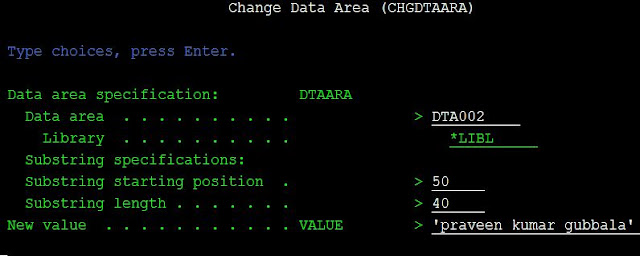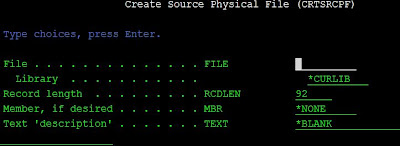Retrieve Job Attributes
- This command is valid only within a CL program or a REXX procedure.
CL var for JOB (10) . . JOB > &NAME
CL var for USER (10) . . USER
CL var for NBR (6) . . NBR
CL var for LOGLVL (1) . . LOGLVL
CL var for LOGSEV (2 0) . . LOGSEV
CL var for LOGTYPE (10) . . LOGTYPE
CL var for LOGCLPGM (10) . . LOGCLPGM
CL var for INQMSGRPY (10) . . INQMSGRPY
CL var for OUTQ (10) . . OUTQ
CL var for OUTQLIB (10) . . OUTQLIB
CL var for ACGCDE (15) . . ACGCDE
CL var for DATE (6) . . DATE
CL var for SWS (8) . . SWS > &NAME1
CL var for TYPE (1) . . TYPE
CL var for RTNCDE (5 0) . . RTNCDE
CL var for ENDSTS (1) . . ENDSTS
CL var for RUNPTY (2 0) . . RUNPTY
CL var for TIMESLICE (7 0) . . TIMESLICE
CL var for PURGE (10) . . PURGE
CL var for DFTWAIT (7 0) . . DFTWAIT
CL var for USRLIBL (2750) . . USRLIBL
CL var for SBMMSGQ (10) . . SBMMSGQ
CL var for SBMMSGQLIB (10) . . SBMMSGQLIB
CL var for PRTTXT (30) . . PRTTXT
CL var for DDMCNV (5) . . DDMCNV
CL var for BRKMSG (7) . . BRKMSG
CL var for DATFMT (4) . . DATFMT
CL var for DATSEP (1) . . DATSEP
CL var for CURLIB (10) . . CURLIB
CL var for PRTDEV (10) . . PRTDEV
CL var for SYSLIBL (165) . . SYSLIBL
CL var for CURUSER (10) . . CURUSER
CL var for SUBTYPE (1) . . SUBTYPE
CL var for PRTKEYFMT (10) . . PRTKEYFMT
CL var for TIMSEP (1) . . TIMSEP
CL var for TSEPOOL (10) . . TSEPOOL
CL var for DEVRCYACN (13) . . DEVRCYACN
CL var for STSMSG (7) . . STSMSG
CL var for SRTSEQ (10) . . SRTSEQ
CL var for SRTSEQLIB (10) . . SRTSEQLIB
CL var for LANGID (3) . . LANGID
CL var for CNTRYID (2) . . CNTRYID
CL var for CCSID (5 0) . . CCSID
CL var for JOBMSGQMX (2 0) . . JOBMSGQMX
CL var for JOBMSGQFL (10) . . JOBMSGQFL
CL var for DFTCCSID (5 0) . . DFTCCSID
CL var for CYMDDATE (7) . . CYMDDATE
CL var for DECFMT (1) . . DECFMT
CL var for CHRIDCTL (10) . . CHRIDCTL
CL var for ASPGRP (10) . . ASPGRP
CL var for SPLFACN (10) . . SPLFACN
CL var for DATETIME (20) . . DATETIME
CL var for TIMZON (10) . . TIMZON
CL var for TIMZONABBR (10) . . TIMZONABBR
CL var for TIMZONFULL (50) . . TIMZONFULL
CL var for TIMOFFSET (3 0) . TIMOFFSET
CL var for THDRSCAFN (20) . . THDRSCAFN
CL var for RSCAFNGRP (10) . . RSCAFNGRP
example:
0001.00 PGM
0002.00 DCL VAR(&NAME) TYPE(*CHAR) LEN(20)
0003.00 DCL VAR(&NAME1) TYPE(*CHAR) LEN(20)
0004.00 RTVJOBA JOB(&NAME) SWS(&NAME1)
0005.00 SNDPGMMSG MSG(&NAME *CAT &NAME1) TOPGMQ(*EXT)
0006.00 SNDPGMMSG MSG(&NAME1) TOPGMQ(*EXT)
0007.00 ENDPGM













